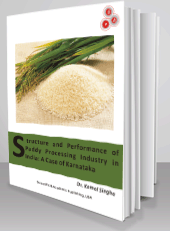Scientific & Academic Publishing
SAP is an open access publisher of journals covering a wide range of academic disciplines.
SAP is an open access publisher of journals covering a wide range of academic disciplines.

Dr. Komol Singha (1972) is an Assistant Professor at Agricultural Development and Rural Transformation Centre in the Institute for Social and Economic Change, Bangalore (India). He obtained his Post Graduate and PhD in Development Economics, and has been teaching economics for 10 years. Before joining Institute for Social and Economic Change, Bangalore (India), he taught economics at Don Bosco College, Manipur (India), St. Joseph’s College, Nagaland (India) and Royal University of Bhutan, Bhutan.
His contributions include, four books- ‘Village Development in North East India’ (ed. 2009; Concept Publishing Company Ltd, New Delhi); ‘Rural Development in India’ (ed. 2010; Concept Publishing Company Ltd, New Delhi); ‘Rural Development in North East India’ (ed. 2010; Concept Publishing Company Ltd. New Delhi) and Economy of a Primitive Tribal village in Manipur (Authored, 2011 Concept Publishing Company Ltd New Delhi), and has contributed number of research papers in the National and the International Journals, Seminars, and Newspapers. His research interest includes the area of- Rural Development, Institutional Economics, Social Capital, Human Capital and Social Sector, etc.
Description
Paddy is the raw output from the field that requires processing. Human beings cannot consume paddy as it is. It has to be suitably processed into rice for human consumption. The need for this process is the basic reason for the existence of the paddy processing industry. As such, the paddy processing is the oldest and largest agro-processing industry in India and Karnataka as well. Almost the entire production (90 per cent) of paddy is converted into rice every year by paddy processing units of varying sizes and capacities spread across the country. The remaining 10 per cent of paddy produced is stored as seed for next season’s crop. It is estimated that about 10 percent of the food grains produced in India is lost in processing due to old and out-dated methods of drying and milling activities. As demand for food grain increases with the growth of population, the need for efficient paddy processing units is felt in the country.
With this understanding, the book attempts to address the economics of paddy processing industries in the state of Karnataka in India, which has been one of the leading producers of paddy in the country. The study further attempts to estimate the highly debated conversion ratios of paddy in the modern rice mills against the tradition huller type of paddy processing units in the state. What are the constraints that have been faced by the paddy processing units in the state is also discussed.
Table of Contents
CHAPTER – I
PADDY CULTIVATION AND MILLING PERSPECTIVE
1. INTRODUCTION
2. THE STATE OF KARNATAKA
3. USES OF PADDY/RICE
4. AREA, PRODUCTION AND YIELD OF PADDY IN KARNATAKA
5. HISTORICAL PERSPECTIVE OF MODERN RICE MILLING
6. STATUS OF RICE MILLING INDUSTRY IN THE STATE
7. OBJECTIVES OF THE STUDY
8. METHODOLOGY AND CHAPTERISATION
CHAPTER – II
HULLING AND MILLING RATIO OF PADDY
1. INTRODUCTION
2. OUTLINE OF MODERNISATION OF MILLS IN INDIA
3. GROWTH OF RICE MILLING IN KARNATAKA
4. TRENDS AND TYPES OF RICE MILLS
5. BASIC CHARACTERISTICS OF THE SELECTED SAMPLE UNITS
6. HULLING AND MILLING RATIOS IN MODERN/TRADITIONAL MILLS
7. DIFFERENCES IN MILLING RATIOS AMONG DIFFERENT MILLS
8. MILLING RATIO BETWEEN OWNER-CUM-TRADER AND CUSTOM HIRING CATEGORY
CHAPTER – III
ECONOMICS OF PADDY PROCESSING
1. INTRODUCTION
2. MARKET INCIDENTALS OF MODERN AND TRADITIONAL MILLS
3. PROCESSING COST OF MODERN AND TRADITIONAL RICE MILLS
4. ECONOMICS OF MODERN MILLS RUNNING UNDER OWNER-CUM- TRADER
5. ECONOMICS OF TRADITIONAL (HULLERS) MILLS RUNNING UNDER CUSTOM HIRING BASIS
6. MARKETING OF PROCESSED RICE BY MODERN AND TRADITIONAL MILLERS
7. STANDARD OF MOISTURE MAINTAINED IN PROCESSING OF PADDY
8. PROCESSING OF PADDY AND ITS BY-PRODUCTS IN MODERN AND TRADITIONAL RICE MILLS
9. RELATIVE SHARES OF DIFFERENT MILLING TECHNIQUES
10. BRIEF ANALYSIS OF ECONOMICS OF PADDY
CHAPTER – IV
CONSTRAINTS FACED BY RICE MILLS
1. INTRODUCTION
2. CAPACITY UTILISATION OF MODERN VERSUS TRADITIONAL RICE MILLS
3. REASONS FOR UNDER UTILISATION OF CAPACITY
4. SUBSIDY/ASSISTANCE OBTAINED (IF ANY) BY RICE MILLS
5. CONSTRAINTS IN PROCESSING OF PADDY
6. STEPS TO OVERCOME THE CONSTRAINTS
CHAPTER V
CONCLUSION AND POLICY RECOMMENDATIONS
1. CONCLUDING NOTE
2. POLICY RECOMMENDATIONS